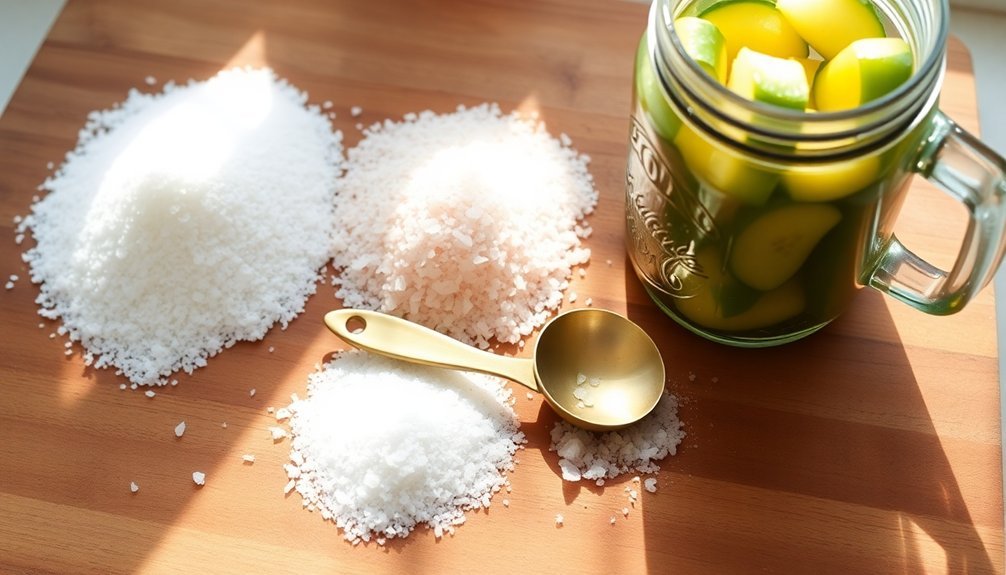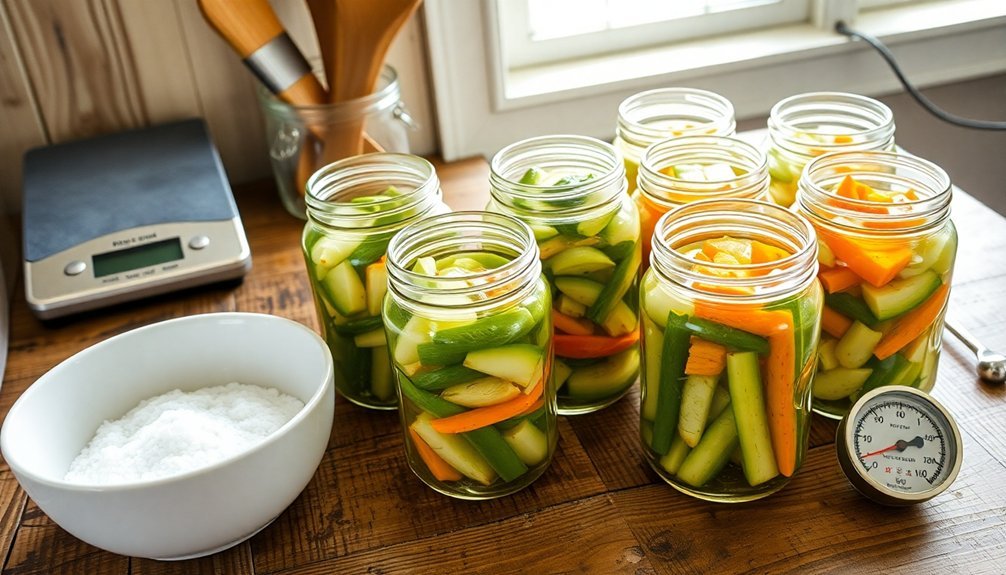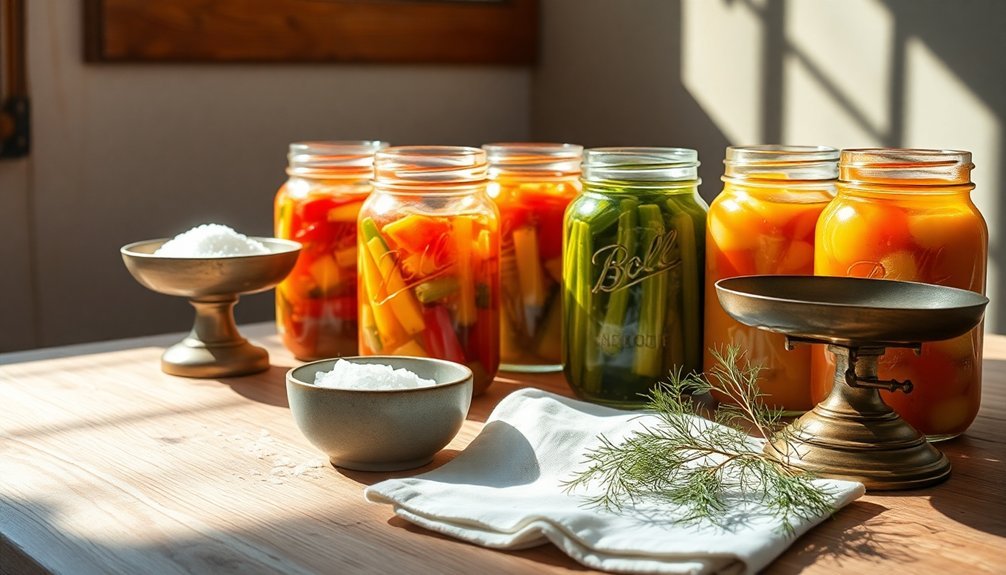Salt-based canning requires specific ingredients and methods to guarantee safe, high-quality preserves. You'll need canning or pickling salt, not table salt, as additives can cause cloudy brine. For meats, use 1 teaspoon per quart jar, while vegetables need similar ratios plus a proper water bath. When pickling, combine salt with 5% vinegar solutions and maintain precise temperatures. Don't substitute ingredients or alter processing times, as these changes can compromise food safety. Follow tested recipes and proper protocols to create shelf-stable preserves that'll last months. Exploring traditional preservation techniques will reveal the secrets to successful home canning.
Selecting the Right Salt

In home canning and pickling, selecting the right salt is essential for both safety and quality. You'll want to use canning and pickling salt specifically designed for food preservation, as it doesn't contain additives that could compromise your preserves.
Unlike table salt, which has anti-caking agents and iodine, canning salt won't cause clouding or discoloration in your brine. Using approved recipes helps ensure safe and successful preservation results.
Don't be tempted to substitute kosher or sea salt in your recipes. While these salts are excellent for cooking, their varying grain sizes can lead to measurement inaccuracies that could affect your food's safety.
Himalayan pink salt and Hawaiian red salt aren't suitable either, as their additional minerals can alter both flavor and appearance.
If you must substitute other salts, you'll need to measure by weight rather than volume to guarantee accuracy. Table salt can serve as a reference point for weight measurements when canning salt isn't available.
Remember to stick to research-based recipes and make appropriate adjustments based on your salt choice. Using the right salt guarantees consistent results and maintains the safety standards necessary for successful home preservation.
Essential Salt Ratios
Precise measurements stand at the heart of safe food preservation. When you're canning meat and poultry, you'll need 1 teaspoon of salt per quart jar or 1/2 teaspoon per pint jar. While salt adds flavor, it's not vital for preservation in pressure-canned meats. Ancient civilizations relied heavily on salt preservation techniques for their food storage needs.
For vegetables like green beans, you can add 1 teaspoon of salt per quart jar using the raw pack method. You'll need to fill jars with raw vegetables, add boiling water, and maintain a 1-inch headspace. Remember, you must use a pressure canner for vegetables, as boiling water canning isn't safe.
When you're pickling or fermenting, salt becomes essential for both safety and flavor. You'll want to use canning or pickling salt specifically, as table salt contains additives that can cause cloudiness. For accurate measurements, it's best to weigh your salt rather than rely on volume.
You'll need to adjust your measurements based on the type of salt you're using. If you're working with kosher salt, use more than the recipe calls for, while powder salt requires less. For coarse salts, always measure by weight to guarantee consistency.
Salt Safety Protocols

Remember that while salt adjustments are safe, other recipe alterations can be dangerous.
You shouldn't modify processing times, substitute fresh herbs for dried ones, or add unauthorized thickeners. Always stick to USDA-endorsed recipes and proper canning methods.
If you're looking to reduce sodium, you can safely add salt substitutes when serving rather than during the canning process. Unsafe recipe modifications can increase the risk of botulism and food spoilage.
Preserving With Salt and Vinegar
Successfully preserving food with salt and vinegar requires precise measurements and careful attention to the brine mixture. You'll need to combine 8 cups of filtered water, 6 cups of 5% vinegar, 1/4 cup sugar, and 1/2 cup salt in a large stockpot. Confirm you're using vinegar with at least 5% acetic acid content for effective preservation.
| Process Step | Key Actions |
|---|---|
| Jar Prep | Clean jars with hot soapy water, add garlic, mustard seed, and dill |
| Brine Fill | Pour boiling brine, leave 1/2 inch headspace, remove bubbles |
| Processing | Maintain 180-185°F water bath for 30 minutes |
While your brine heats to a boil, prepare your canning jars by washing them thoroughly and placing them on a kitchen towel. You'll want to pack your cucumbers tightly, leaving just enough space for the brine. After filling the jars with boiling brine, use a bubble remover to release any trapped air. Secure new two-part lids until fingertip tight, then process in your water bath. Remember to let the jars rest for 12 hours before checking seals, and don't forget to label them before storage.
Testing Salt Concentration Methods

Testing salt concentration in your home canning projects requires both accurate measurement tools and consistent methods for reliable results.
You'll need to understand that different salt types, such as kosher or pickling salt, vary in weight per volume, which directly affects your measurements.
When testing salt levels, you'll want to use canning or pickling salt as your standard, since it doesn't contain additives that could affect your results.
Don't rely on salt substitutes during the canning process, as they can create unpleasant flavors when exposed to high heat. If you're using Redmond Real Salt, you can proceed normally, as it's suitable for canning and adds beneficial minerals.
Remember that salt isn't essential for preservation – it's primarily for flavor.
You can safely reduce or omit salt in most canned goods except pickles, where salt concentration affects the final product's texture and taste.
If you're adjusting recipes, maintain consistency by converting measurements based on salt coarseness.
For low-sodium options, wait until serving time to add salt substitutes.
Always follow research-based recipes from trusted sources like the USDA, and verify you're using proper processing methods based on food acidity.
Frequently Asked Questions
Can I Reuse Leftover Pickling Brine for a New Batch?
You shouldn't reuse brine for canning, but you can use it for refrigerator pickles. Just keep these quick pickles refrigerated and consume within 3-4 weeks for the best quality and safety.
How Long Should I Wait Before Testing Jar Seals?
You'll need to wait 24 hours or overnight before testing your jar seals. Let them cool completely on a folded towel, and don't touch the lids during this time to prevent false seals.
Why Did My Pickles Turn Hollow During Storage?
Your pickles likely turned hollow because you've waited too long between harvesting and processing, or your cucumbers weren't ideal for pickling. High storage temperatures and moisture loss can also cause hollow centers.
Does Altitude Affect Salt Concentration in Fermented Foods?
No, altitude doesn't affect salt concentration in your fermented foods. While you'll need to adjust processing times for canning at higher altitudes, the ideal salt percentage for successful fermentation remains constant regardless of elevation.
Can I Mix Different Types of Salt if Running Low?
You shouldn't mix different salts for fermented foods as it can affect safety and consistency. For non-fermented recipes, you can mix salts, but it's best to measure by weight to maintain proper proportions.
In Summary
Whether you're preserving summer vegetables or creating fermented delicacies, proper salt-based canning guarantees your food stays safe and flavorful. You'll find success by selecting the right salt type, following tested ratios, and maintaining strict safety protocols. Don't skip testing salt concentrations or combining salt with vinegar when recipes call for it. With these time-honored methods, you're well-equipped to create shelf-stable preserves your family will enjoy year-round.





Leave a Reply